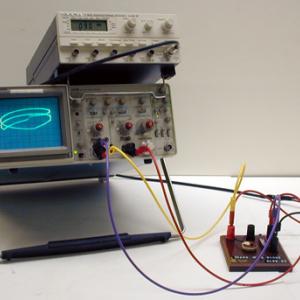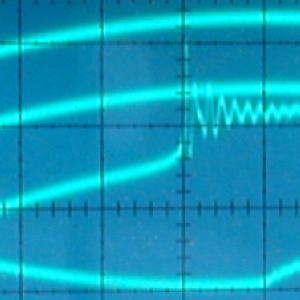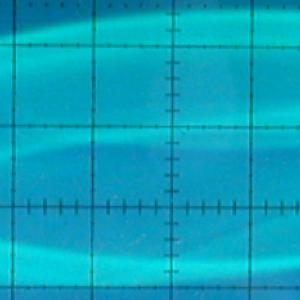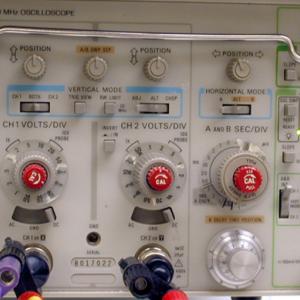College of Liberal Arts & Sciences
3A95.55 - Change of a Diode
See also 3A95.55 in Chaos and Rube Goldberg.
Set the oscilloscope to XY plot and connect to the circuit board. The wave generator should be set at 90 to 135 Khz. A stable trace should be shown on the oscilloscope until you change the initial conditions slightly with the DC offset of the wave generator. At that time the trace will go into a chaotic oscillation.
- Richard V. Mancuso and Elise M. Somerset, "Changing of the State of a Diode and Chaos", TPT, Vol. 35, #1, Jan. 1997, p. 31.
- Ishan Deo, Krishnacharya Khare, "A Simple Electronic Circuit Demonstrating Hopf Bifurcation for an Advanced Undergraduate Laboratory", AJP, Vol. 90, #12, Dec. 2022, p. 908.
- Richard J. Wiener, Kristine E. Callan, Stephen C. Hall, and Thomas Olsen, "Proportional Feedback Control of Chaos in a Simple Electronic Oscillator", AJP, Vol. 74, #3, Mar. 2006, p. 200.
- Prodyot Kumar Roy, Arijit Basuray, Emanuel Gluskin, "On Power Supplies Used for Laboratory Demonstration of Chaotic Electronic Oscillators", AJP, Vol. 73, #11, Nov. 2005, p. 1082.
- Ken Kiers, Dory Schmidt, and J. C. Sprott, "Precision Measurements of a Simple Chaotic Circuit", AJP, Vol. 72, #4, Apr. 2004, p. 503.
- Ned J. Corron, Shawn D. Pethel, and Buckley A. Hopper, "A Simple Electronic System for Demonstrating Chaos Control", AJP, Vol. 72, #2, Feb. 2004, p. 272.
- Daniel J. Gauthier, "Resource Letter: CC-1: Controlling Chaos", AJP, Vol. 71, #8, Aug. 2003, p. 750.
- Prodyot Kumar Roy and Arijit Basuray, "A High Frequency Chaotic Signal Generator: A Demonstration Experiment", AJP, Vol. 71, #1, Jan. 2003, p. 34.
- B. K. Jones and G. Trefan, "The Duffing Oscillator: A Precise Electronic Analog Chaos Demonstrator for the Undergraduate Laboratory", AJP, Vol. 69, #4, Apr. 2001, p. 464.
- J. C. Sprott, "Simple Chaotic Systems and Circuits", AJP, Vol. 68, #8, Aug. 2000, p. 758.
- Thomas P. Weldon, "An Inductorless Double Scroll Chaotic Circuit", AJP, Vol. 58, #10, Oct. 1990, p. 936.
- Keith Briggs, "Simple Experiments in Chaotic Dynamics", AJP, Vol. 55, #12, Dec. 1987, p. 1083.
- E. L. M. Flerackers, H. J. Janssen, and L. Beerden, "Piecewise Linear Anharmonic LRC Circuit for Demonstrating 'Soft' and 'Hard' Spring Nonlinear Resonant Behavior", AJP, Vol. 53, #6, June 1985, p. 574.
- T. Mishina, T. Kohmoto, and T. Hashi, "Simple Electronic Circuit for the Demonstration of Chaotic Phenomena", AJP, Vol. 53, #4, Apr. 1985, p. 332.
- H. J. T. Smith and K. A. Woolner, "Inexpensive Demonstration of an Anharmonic Oscillator", AJP, Vol. 52, #9, Sep. 1984, p. 800.
- Julien Clinton Sprott, "4.9. Chaotic Circuits", Physics Demonstrations, ISBN 0-299-21580-6, p. 204., #9, Sep.
- Douglas Smith, "How to Generate Chaos At Home", The Amateur Scientist, Jan. 1992.
Disclaimer: These demonstrations are provided only for illustrative use by persons affiliated with The University of Iowa and only under the direction of a trained instructor or physicist. The University of Iowa is not responsible for demonstrations performed by those using their own equipment or who choose to use this reference material for their own purpose. The demonstrations included here are within the public domain and can be found in materials contained in libraries, bookstores, and through electronic sources. Performing all or any portion of any of these demonstrations, with or without revisions not depicted here entails inherent risks. These risks include, without limitation, bodily injury (and possibly death), including risks to health that may be temporary or permanent and that may exacerbate a pre-existing medical condition; and property loss or damage. Anyone performing any part of these demonstrations, even with revisions, knowingly and voluntarily assumes all risks associated with them.



